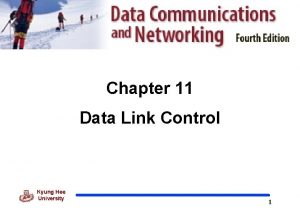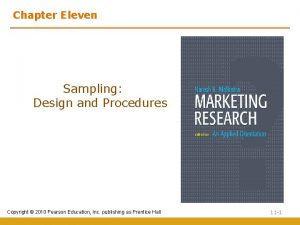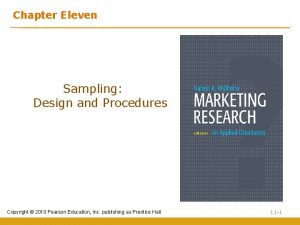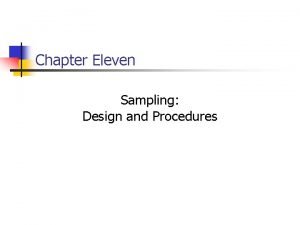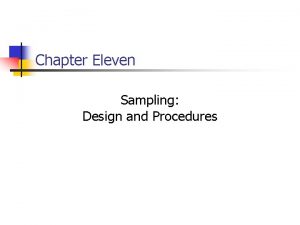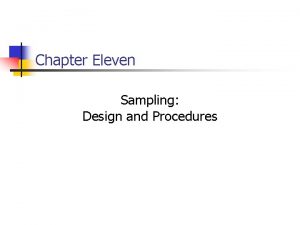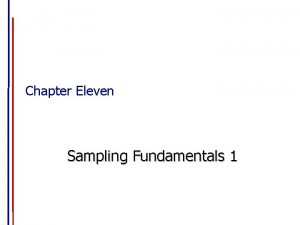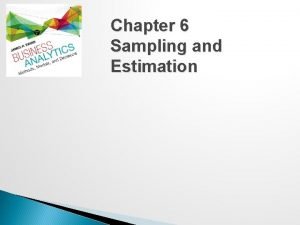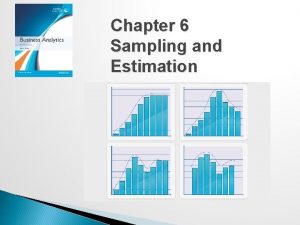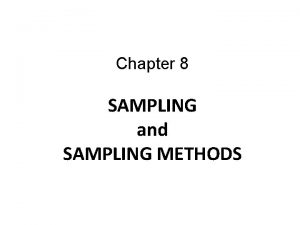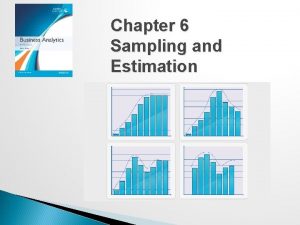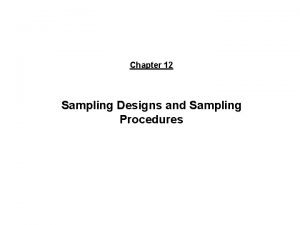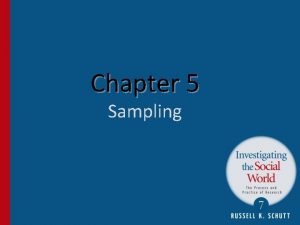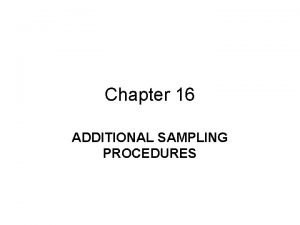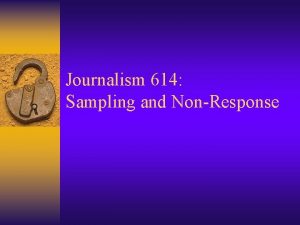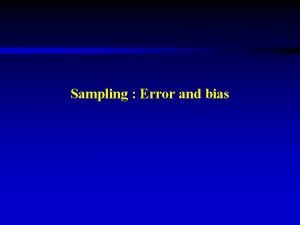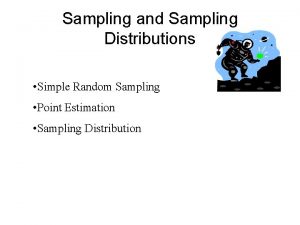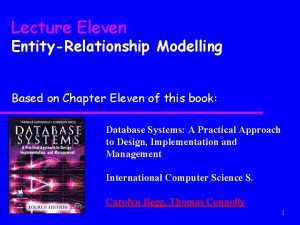Chapter Eleven Sampling Design and Procedures Copyright 2010



























- Slides: 27

Chapter Eleven Sampling: Design and Procedures Copyright © 2010 Pearson Education, Inc. 11 -1

Chapter Outline 1) Overview 2) The Sampling Design Process i. Define the Target Population ii. Determine the Sampling Frame iii. Select a Sampling Technique iv. Determine the Sample Size v. Execute the Sampling Process Copyright © 2010 Pearson Education, Inc. 11 -2

Chapter Outline 4) A Classification of Sampling Techniques i. Nonprobability Sampling Techniques a. Convenience Sampling b. Judgmental Sampling c. Quota Sampling d. Snowball Sampling ii. Probability Sampling Techniques a. Simple Random Sampling b. Systematic Sampling c. Stratified Sampling d. Cluster Sampling Copyright © 2010 Pearson Education, Inc. 11 -3

Copyright © 2010 Pearson Education, Inc. 11 -4

Sampling is the process of selecting a small number of elements from a larger defined target group of elements such that the information gathered from the small group will allow judgments to be made about the larger groups Copyright © 2010 Pearson Education, Inc. 11 -5

The Sampling Design Process Fig. 11. 1 Define the Population Determine the Sampling Frame Select Sampling Technique(s) Determine the Sample Size Execute the Sampling Process Copyright © 2010 Pearson Education, Inc. 11 -6

Define the Target Population The target population is the collection of elements or objects that possess the information sought by the researcher and about which inferences are to be made. The target population should be defined in terms of elements, sampling units, extent, and time. • An element is the object about which or from which the information is desired, e. g. , the respondent. • A sampling unit is an element, or a unit containing the element, that is available for selection at some stage of the sampling process. • Extent refers to the geographical boundaries. • Time is the time period under consideration. Copyright © 2010 Pearson Education, Inc. 11 -7

Yasar University Student Satisfaction Survey • Element: Yasar University’s enrolled student • Sampling units: Faculties, institutes, vocational school • Extent: Izmir • Time 2017 Copyright © 2010 Pearson Education, Inc. 11 -8

Define the Target Population Important qualitative factors in determining the sample size are: • • the importance of the decision the nature of the research the number of variables the nature of the analysis sample sizes used in similar studies response rates resource constraints (time, budget, software, human resources…) Copyright © 2010 Pearson Education, Inc. 11 -9

Sample Sizes Used in Marketing Research Studies Table 11. 2 Copyright © 2010 Pearson Education, Inc. 11 -10

Classification of Sampling Techniques Fig. 11. 2 Sampling Techniques Nonprobability Sampling Techniques Convenience Sampling Judgmental Sampling Simple Random Sampling Systematic Sampling Copyright © 2010 Pearson Education, Inc. Probability Sampling Techniques Quota Sampling Stratified Sampling Snowball Sampling Cluster Sampling Other Sampling Techniques 11 -11

Nonprobability sampling approach • Relies on personal judgement of the researcher • The researcher can arbitrarily or consciously decide what elements to include • They do not allow objective evaluations • They still may yield good estimates Copyright © 2010 Pearson Education, Inc. 11 -12

Convenience Sampling Convenience sampling attempts to obtain a sample of convenient elements. Often, respondents are selected because they happen to be in the right place at the right time. • Use of students, and members of social organizations • Mall intercept interviews without qualifying the respondents • Department stores using charge account lists • “People on the street” interviews Copyright © 2010 Pearson Education, Inc. 11 -13

Judgmental Sampling Judgmental sampling is a form of convenience sampling in which the population elements are selected based on the judgment of the researcher. • Test markets • Purchase engineers selected in industrial marketing research • Expert respondents Copyright © 2010 Pearson Education, Inc. 11 -14

Quota Sampling Quota sampling may be viewed as two-stage restricted judgmental sampling. • The first stage consists of developing control categories, or quotas, of population elements. • In the second stage, sample elements are selected based on convenience or judgment. Control Variable Sex Male Female Population composition Sample composition Percentage Number 48 52 ____ 100 Copyright © 2010 Pearson Education, Inc. 48 52 ____ 100 480 520 ____ 1000 11 -15

Snowball Sampling In snowball sampling, an initial group of respondents is selected first • After being interviewed, these respondents are asked to identify others who belong to the target population of interest. • Subsequent respondents are selected based on the referrals. Copyright © 2010 Pearson Education, Inc. 11 -16

Simple Random Sampling Simple random sampling (SRS) is a method of probability sampling in which every unit has an equal nonzero chance of being selected Copyright © 2010 Pearson Education, Inc. 11 -17

Systematic Random Sampling • The sample is chosen by selecting a random starting point and then picking every ith element in succession from the sampling frame. • The sampling interval, i, is determined by dividing the population size N by the sample size n and rounding to the nearest integer. • When the ordering of the elements is related to the characteristic of interest, systematic sampling increases the representativeness of the sample. Copyright © 2010 Pearson Education, Inc. 11 -18

Systematic Sampling • If the ordering of the elements produces a cyclical pattern, systematic sampling may decrease the representativeness of the sample. For example, there are 7000 elements (students) in Yasar University (the population) and a sample of 350 is desired. In this case the sampling interval, i, is 20. A random number between 1 and 20 is selected. If, for example, this number is 3, the sample consists of elements 3, 23, 43, 63, 83, 103, and so on. Copyright © 2010 Pearson Education, Inc. 11 -19

Stratified Sampling • A two-step process in which the population is partitioned into subpopulations, or strata. • The strata should be mutually exclusive and collectively exhaustive in that every population element should be assigned to one and only one stratum and no population elements should be omitted. (Undergraduate and graduate students) • Next, elements are selected from each stratum by a random procedure. • A major objective of stratified sampling is to increase precision without increasing cost. Copyright © 2010 Pearson Education, Inc. 11 -20

Cluster Sampling Cluster sampling is a method of probability sampling where the sampling units are selected in groups rather than individually Copyright © 2010 Pearson Education, Inc. 11 -21

Cluster Sampling • The target population is first divided into mutually exclusive and collectively exhaustive subpopulations, or clusters. (e. g. Different neighbourhoods of a city) • Then a random sample of clusters is selected, based on a probability sampling technique. • For each selected cluster, either all the elements are included in the sample (onestage) or a sample of elements is drawn probabilistically (two-stage). Copyright © 2010 Pearson Education, Inc. 11 -22

Strengths and Weaknesses of Basic Sampling Techniques Table 11. 4 Technique Strengths Weaknesses Nonprobability Sampling Convenience sampling Least expensive, least time-consuming, most convenient Low cost, convenient, not time-consuming Sample can be controlled for certain characteristics Can estimate rare characteristics Selection bias, sample not representative, not recommended for descriptive or causal research Does not allow generalization, subjective Selection bias, no assurance of representativeness Time-consuming Easily understood, results projectable Difficult to construct sampling frame, expensive, lower precision, no assurance of representativeness Can decrease representativeness Judgmental sampling Quota sampling Snowball sampling Probability sampling Simple random sampling (SRS) Systematic sampling Stratified sampling Cluster sampling Can increase representativeness, easier to implement than SRS Include all important subpopulations, precision Easy to implement, cost effective Copyright © 2010 Pearson Education, Inc. Difficult to select relevant stratification variables, not feasible to stratify on many variables, expensive Imprecise, difficult to compute and interpret results 11 -23

Choosing Nonprobability Vs. Probability Sampling Table 11. 4 Copyright © 2010 Pearson Education, Inc. 11 -24

Copyright © 2010 Pearson Education, Inc. 11 -25

Next Week: Consultation and report submission for TA A report will be submitted covering: Research Design • Your research objective • Importance of the subject • Secondary Data Findings • Research Methods planned to be used • Qualitative section (explanations) • Quantitive section (explanations) • Target population-sampling issues • Analysis methods planned • Expected results of the research Copyright © 2010 Pearson Education, Inc. 11 -26

All rights reserved. No part of this publication may be reproduced, stored in a retrieval system, or transmitted, in any form or by any means, electronic, mechanical, photocopying, recording, or otherwise, without the prior written permission of the publisher. Printed in the United States of America. Copyright © 2010 Pearson Education, Inc. publishing as Prentice Hall Copyright © 2010 Pearson Education, Inc. 11 -27
 Qa sampling procedures
Qa sampling procedures Copyright 2010 pearson education inc
Copyright 2010 pearson education inc Copyright 2010
Copyright 2010 Copyright 2010
Copyright 2010 Copyright 2010 pearson education inc
Copyright 2010 pearson education inc Copyright 2010 pearson education inc
Copyright 2010 pearson education inc Copyright 2010
Copyright 2010 Nwoz
Nwoz Copyright 2010 pearson education inc
Copyright 2010 pearson education inc Copyright 2010 pearson education inc
Copyright 2010 pearson education inc Copyright 2010 pearson education inc
Copyright 2010 pearson education inc 2010 pearson education inc
2010 pearson education inc Copyright 2010 pearson education inc
Copyright 2010 pearson education inc Copyright 2010 pearson education inc
Copyright 2010 pearson education inc Pearson education inc all rights reserved
Pearson education inc all rights reserved A consumer confidence researcher asks several retailers
A consumer confidence researcher asks several retailers Panel sampling
Panel sampling Convenience sampling images
Convenience sampling images Contoh time sampling dalam observasi
Contoh time sampling dalam observasi Cluster random sampling vs stratified
Cluster random sampling vs stratified Define sampling
Define sampling Natural sampling vs flat top sampling
Natural sampling vs flat top sampling Piggybacking in go-back-n arq
Piggybacking in go-back-n arq Chapter 47 laboratory materials and procedures
Chapter 47 laboratory materials and procedures Chapter 15 diagnostic procedures and pharmacology
Chapter 15 diagnostic procedures and pharmacology Chapter 12 banking procedures and services
Chapter 12 banking procedures and services Dermal puncture equipment
Dermal puncture equipment Chapter 10 workplace safety procedures
Chapter 10 workplace safety procedures






















